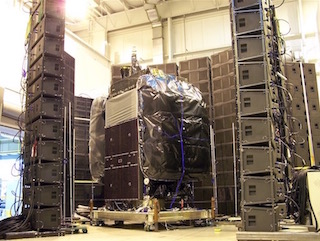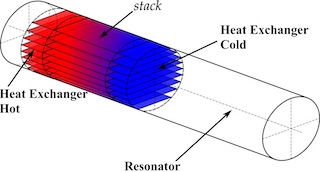Apr 21st, 2016 - Category: Sound
Over the years, I’ve come across some very strange and fascinating uses for acoustics. Here are my top 5 favorites.
- Acousto-Magnetic Security Tags - Those little tags that are used to prevent theft in stores use a passive acoustic technology. A thin strip of metal is acoustically tuned to resonate at 58 kHz. When exposed to an oscillating magnetic field at 58 kHz, magnetostriction causes the strip to vibrate which alerts the scanner at the store exit. Applied Science has a great video explaining the process in detail.
 Satellite Acoustic Testing - Acoustic levels during launch can exceed 154 dB so satellites are tested at high acoustic and vibration levels to insure survivability. It used to be done with massive acoustic horns driven by nitrogen, but now levels as high as 147 dB can be generated by a system called Direct Field Acoustic Testing (DFAT®) that utilizes concert loudspeaker arrays. Now that’s rock and roll!
Satellite Acoustic Testing - Acoustic levels during launch can exceed 154 dB so satellites are tested at high acoustic and vibration levels to insure survivability. It used to be done with massive acoustic horns driven by nitrogen, but now levels as high as 147 dB can be generated by a system called Direct Field Acoustic Testing (DFAT®) that utilizes concert loudspeaker arrays. Now that’s rock and roll!- Long Range Acoustic Device LRAD (aka the Acoustic Cannon) - Originally an acoustic hailing device, it became famous when it was used to repel pirates attacking a cruise ship off the coast of Somalia. According to Wikipedia, it is used by maritime, law enforcement, military and commercial security companies to send instructions and warnings over distance. LRAD systems are also used to deter wildlife from airport runways, wind and solar farms, nuclear power facilities, gas and oil platforms, mining and agricultural operations, and industrial plants.
- Acoustic Tractor Beams - I wrote about these in 2015, but they are worth mentioning again because the technology is so amazing. Recently, they have found use in containerless processing, acoustic tweezers, and acoustic levitation (Acoustophoresis).
- Acoustic Refrigeration
 (aka a Thermoacoustic heat engine) - I saw one of these in operation at a laboratory in New Mexico years ago. Strangely enough, Penn State made a unit for Ben and Jerry’s back in 2004 which made the news on NPR. 190 dB at 100 Hz is definitely an impressive way to keep your ice cream cold.
(aka a Thermoacoustic heat engine) - I saw one of these in operation at a laboratory in New Mexico years ago. Strangely enough, Penn State made a unit for Ben and Jerry’s back in 2004 which made the news on NPR. 190 dB at 100 Hz is definitely an impressive way to keep your ice cream cold.
If you’re interested in more, there’s actually a book about the science of the sonic wonders of the world called The Sound Book by Trevor Cox. It covers phenomena like incredible reverberation, ringing rocks, barking fish, singing sands, and extreme quiet. Acoustics really is incredible.